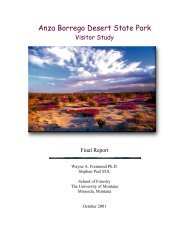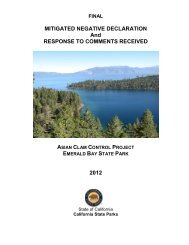the conference program - California State Parks - State of California
the conference program - California State Parks - State of California
the conference program - California State Parks - State of California
You also want an ePaper? Increase the reach of your titles
YUMPU automatically turns print PDFs into web optimized ePapers that Google loves.
Bicycle/Pedestrian Bridge Engineering<br />
101 (Part 1)<br />
This is <strong>the</strong> fi rst <strong>of</strong> a two part session on <strong>the</strong><br />
investigation, design and construction process<br />
involved in bicycle and pedestrian bridges,<br />
including: a) selecting a bridge location, b)<br />
site investigations (hydraulic and geotechnical<br />
analysis over-view) c) foundation and abutment<br />
types and designs, d) kinds and types <strong>of</strong> bridges,<br />
e) bridge plans and selection, f) review <strong>of</strong><br />
pedestrian under-crossings and over-crossings,<br />
g) construction issues, h) permits, and i) typical<br />
costs. The second part <strong>of</strong> this session will<br />
immediately follow at 2:30 p.m.<br />
Syd Temple, Principal, Questa Engineering<br />
Paul Jacobs, Technical Representative, Contech<br />
Bridge Solutions<br />
Wildlife Encounters & Trail Use<br />
This presentation will review common species<br />
in <strong>the</strong> area, <strong>the</strong>ir habitats and how trails and<br />
users have impacted wildlife. As more people<br />
use <strong>the</strong> trails <strong>the</strong>re are more wildlife encounters<br />
and sightings perceived as threats. Some <strong>of</strong><br />
<strong>the</strong> dangers associated with <strong>the</strong>se encounters<br />
can be deadly. There are preventive measures<br />
that can be taken to minimize risks, such as<br />
education, walking with a partner, keeping<br />
dogs on leash, and being alert. Learn how<br />
to educate trail users to properly respond to<br />
wildlife encounters, and when it’s appropriate<br />
to contact <strong>the</strong> <strong>California</strong> Department <strong>of</strong> Fish &<br />
Game.<br />
Nicole Kozicki, Fish & Game Warden, <strong>California</strong><br />
Department <strong>of</strong> Fish & Game<br />
SSessions e s s i o n s<br />
10<br />
2:30-3:30 PM<br />
Green by Nature: Innovative Examples for<br />
Diverse Connection<br />
The Children In Nature Collaborative is a<br />
vibrant grassroots movement and ecosystem<br />
<strong>of</strong> partnerships to connect children, youth<br />
and adults to nature in meaningful ways. This<br />
session will feature three local partners; Bay<br />
Area Wilderness Training, Outdoor Afro, and<br />
<strong>the</strong> Girl Scouts <strong>of</strong> Nor<strong>the</strong>rn <strong>California</strong>. Come<br />
learn how each group works to connect diverse<br />
populations to <strong>the</strong> natural world through<br />
innovative tools and <strong>program</strong>s.<br />
Elizabeth Hales, M.Ed., Community Outreach<br />
Coordinator, East Bay Regional Park District<br />
Kyle MacDonald, Founder, CEO, Bay Area<br />
Wilderness Training<br />
Rue Mapp, Executive Director, Outdoor Afro<br />
Kymberly Miller, Program Director, Environment,<br />
Girl Scouts <strong>of</strong> Nor<strong>the</strong>rn <strong>California</strong><br />
Technology for Fun Sustainable Trails<br />
Technology makes it fairly easy to assess existing<br />
trails and locate new ones by evaluating site<br />
attributes, such as slope, soil, sensitive species<br />
and habitats…perhaps too easy. Unfortunately,<br />
resulting trails can be too wide, too straight and<br />
without anything <strong>of</strong> interest left in place. As trail<br />
designers, we know that <strong>the</strong> narrower and more<br />
winding <strong>the</strong> trail, <strong>the</strong> more sustainable it is. This<br />
also makes it more attractive to a wide range<br />
<strong>of</strong> users. How can we integrate more qualitative<br />
values into <strong>the</strong> planning process by defi ning<br />
routes designed to assure sustainability while<br />
enhancing <strong>the</strong> trail experience for all?<br />
John Eric Holloway, ASLA, LCI, Sr. Associate,<br />
KTU+A Planning + Landscape Architecture<br />
Mark Carpenter, GISP, Sr. Associate, KTU+A<br />
Planning + Landscape Architecture

















